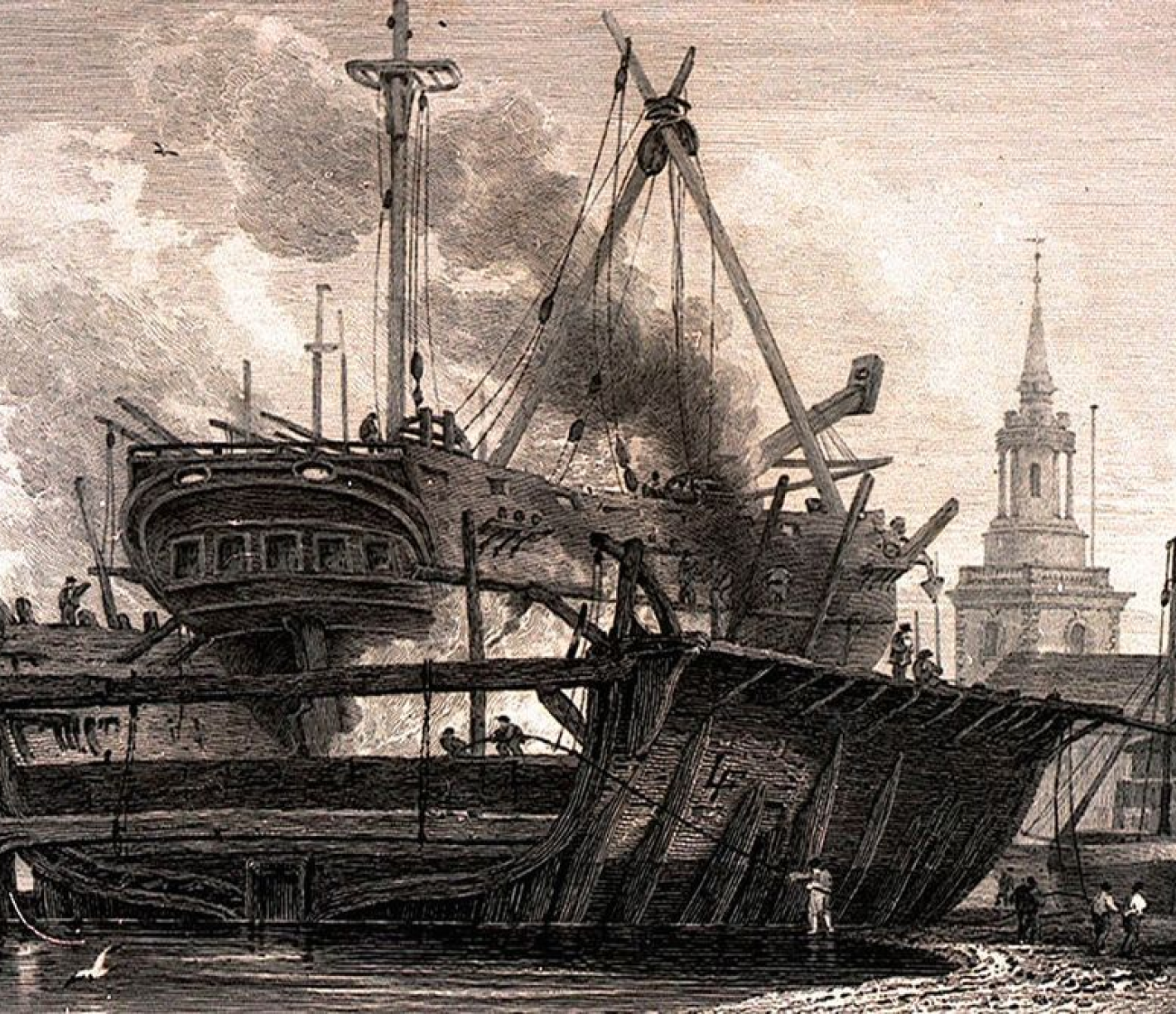

History
A world by the water
The Surrey Docks were once the heart of London’s timber trade.
This is where the big ships came in from Canada and the Baltic. Where the Mayflower sailed from. And dockworkers, from Scandinavia to Malaysia, unloaded thousands of tonnes of timber a day. Today, Rotherhithe, Canada Water and Surrey Docks form the Rotherhithe peninsula, one of London’s most distinctive neighbourhoods, with a landscape and history that have been shaped by water. Once low-lying marshland, this riverside location became a globally important commercial and maritime hub.
Here some of the world’s most famous ships were built, moored and repaired, while timber, grain and other imports from around the world were unloaded in vast quantities along its docksides and wharves. Alongside this a community with a distinctive working culture emerged.
In the 20th century the shape of the area was completely transformed: firstly, through devastating air raids in World War II; then through the closure of the docks; and again through the building of new homes, arrival of new residents and businesses, and dramatic reshaping of the landscape by the London Docklands Development Corporation (LDDC) towards the end of the century.
Across the centuries, this has always been a place of commerce, and a melting pot of cultures.



Connecting London to the world
The defining feature of the Rotherhithe peninsula has been the development of the docks, which have played a central role in London’s world wide trade over the centuries.
The Rotherhithe and Surrey Docks lay on the floodplains of the Thames, an area that had not seen extensive settlement. Romans built the Old Kent Road to connect Londinium and Dover – a route that still exists today. From early on, road networks by-passed the peninsula.
The area was also called Redriff by the local residents, referring to the red gravel which could be seen at low tide.

1600
On our doorstep: Greenland Dock
1696 saw the start of construction on Howland Great Dock. London’s oldest wet dock, it initially housed ships being refitted for the East India Company, but from the 1760s it received whaling ships coming in from the far north – leading to the name it is known by today: Greenland Dock. It is one of the few Rotherhithe docks to survive the rise of container shipping in the 1960s, which led to the eventual decline and filling in of most working docks in the area in the 1980s.

1700s
Southwark Park: built for health
Southwark Park was opened in 1869 to serve the expanding Bermondsey community. And here you’ll find London’s first public memorial to a working class man - a drinking fountain to commemorate Mr Jabez West, a member of a local Temperance Society.
Southwark Park’s Ada Salter Garden was opened in 1936 by the London County Council. It was designed by Ada herself, an extraordinary and much-loved local social reformer - one of the first women councillors in London and the first woman Mayor - who worked tirelessly to improve life opportunities for women and working class people.

1869
The heart of Canada Water
Constructed in 1876 on the site of two former timber ponds, Canada Dock was the first major scheme of the Surrey Commercial Docks Company, built to receive timber – in particular from North America.
Neighbouring ponds and docks across 460 acres were linked by small ‘Cuts’ of water, lined by large scale sheds and yards for the storage and offloading of goods.
At Canada Dock, timber was taken off the ships, floated, and stacked into specialist dockside sheds by the skilled deal porters – ‘deal’ being another name for timber.

1876
Local history, restored for another generation
The Dock Managers Offices were built in 1892 for the Surrey Commercial Docks. The Offices remained in continuous operation with little alteration in the twentieth century, until the gradual decline in the need for timber in building construction led to the closure of the commercial docks in 1969.
Subsequently the building was left unused until 1985; it now houses commercial occupiers and has recently been restored and refurbished to house the Project Hub for the Canada Water Masterplan.

1892
The acrobats of Canada Dock
A characteristic sight of the docks were the Deal Porters, dockers who specialised in carrying huge baulks of deal (timber) across their shoulders and wore special headgear to protect their heads from the rough wood - athletic men who unloaded, carried and stacked the timber.

1930
A time of change
The decline of the docks began after the Second World War. The docks were a key target for bombing and suffered substantial damage during the war. Many of the warehouses were damaged beyond repair or were completely destroyed. As well as the damage inflicted during the war, the introduction of the container shipping system for cargo transport led to the decline of the docks, as goods were unshipped much further down the Thames. The Surrey Commercial Docks became unprofitable and eventually closed in 1969.

1969
An extraordinary transformation
Following the closure of the docks in the early 1970s, the area was redeveloped by the London Docklands Development Corporation. Russia Dock Woodland was planted on the site of a number of docks, including Russia Dock, Island Dock and Surrey Basin, to create a 34.5-acre woodland in 1980. The Woodland still contains surviving dock features including the retaining wall capstones, depth gauges, bollards, mooring chains and tracks.
Today Russia Dock Woodland and Stave Hill Ecological Park offer a peaceful oasis, home to 160 species of birds.

1980
Serving Southwark's residents
Surrey Quays Shopping Centre opened in 1988, built on top of an infilled section of Canada Dock and forming part of the wider development of the former docks, including 5,500 homes and a leisure park. Today it forms the commercial heart of Canada Water, an important amenity for local residents.

1988
Connected by London's best transport infrastructure
Canada Water tube station opened in 1999, bringing the new Jubilee line to the Rotherhithe peninsula. The Zone 2 station is a purpose-built building located on a site formerly occupied by Albion Dock, part of the old Surrey Commercial Docks.
The station was one of the first designed for the Jubilee line extension, connecting the formerly isolated Surrey Docks area to Waterloo, the West End, and Canary Wharf and Stratford to the east.
Overground services linking the area north and south commenced in 2010, creating an important transport interchange and making Canada Water one of the most easily accessible areas in London.

1999
The Printworks: a unique modern industrial heritage
The Daily Mail Group’s Harmsworth Quays printing works was built on the site of Quebec Dock. As the former printing hub of The Evening Standard, The Daily Mail and The Metro, all operated from here for 24 years until its closure in 2013.
Now owned by British Land, the exceptional industrial spaces of the Printworks are home to cultural destination Printworks London, which opened its doors in 2017 and has hosted more than 2 million people across its award-winning electronic and live music nights, corporate events, festivals and more.

2017

“Practically every Sunday during the summer, you’d have the rowing clubs… All dockers & lightermen… And old pleasure boats.”
Bill Lindley, On the River: Memories of a Working River

Our local Commitments
The Canada Water Masterplan is a partnership between British Land, Southwark Council and the local community to create an outstanding new town centre for Southwark and make a positive long-term contribution to local life.

Sustainable Workspace
The Canada Water Masterplan will deliver up to 2 million sq ft of highly sustainable workspace in the UK's largest cluster of BREEAM Outstanding buildings.



